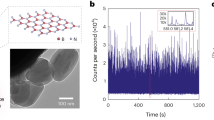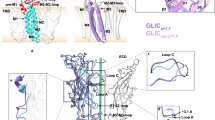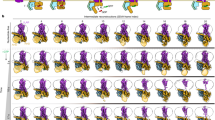Abstract
The hydroxide ion plays an important role in many chemical and biochemical processes in aqueous solution1. But our molecular-level understanding of its unusual and fast transport in water, and of the solvation patterns that allow fast transport, is far from complete. One proposal seeks to explain the properties and behaviour of the hydroxide ion by essentially regarding it as a water molecule that is missing a proton2, and by inferring transport mechanisms and hydration structures from those of the excess proton. A competing proposal invokes instead unique and interchanging hydroxide hydration complexes, particularly the hypercoordinated OH-(H2O)4 species and tri-coordinated OH-(H2O)3 that can form a transient hydrogen bond between the H atom of the OH- and a neighbouring water molecule3,4,5. Here we report measurements of core-level photoelectron emission and intermolecular Coulombic decay6,7,8 for an aqueous hydroxide solution, which show that the hydrated hydroxide ion is capable of transiently donating a hydrogen bond to surrounding water molecules. In agreement with recent experimental studies of hydroxide solutions9,10,11,12, our finding thus supports the notion that the hydration structure of the hydroxide ion cannot be inferred from that of the hydrated excess proton.
This is a preview of subscription content, access via your institution
Access options
Subscribe to this journal
Receive 51 print issues and online access
$199.00 per year
only $3.90 per issue
Buy this article
- Purchase on Springer Link
- Instant access to full article PDF
Prices may be subject to local taxes which are calculated during checkout


Similar content being viewed by others
References
Hynes, J. T., Klinman, J. P., Limbach, H.-H. & Schowen, R. L. E. Hydrogen-Transfer Reactions Ch. 21 (Wiley, 2007)
Asthagiri, D., Pratt, L. R., Kress, J. D. & Gomez, M. A. Hydration and mobility of HO-(aq). Proc. Natl Acad. Sci. USA 101, 7229–7233 (2004)
Chandra, A., Tuckerman, M. E. & Marx, D. Connecting solvation shell structure to proton transport kinetics in hydrogen-bonded networks via population correlation functions. Phys. Rev. Lett. 99, 145901 (2007)
Tuckerman, M. E., Chandra, A. & Marx, D. Structure and dynamics of OH-(aq). Acc. Chem. Res. 39, 151–158 (2006)
Tuckerman, M. E., Marx, D. & Parrinello, M. The nature and transport mechanism of hydrated hydroxide ions in aqueous solution. Nature 417, 925–929 (2002)
Cederbaum, L. S., Zobeley, J. & Tarantelli, F. Giant intermolecular decay and fragmentation of clusters. Phys. Rev. Lett. 79, 4778–4781 (1997)
Averbukh, V., Müller, I. B. & Cederbaum, L. S. Mechanism of interatomic Coulombic decay in clusters. Phys. Rev. Lett. 93, 263002 (2004)
Müller, I. B. & Cederbaum, L. S. Ionization and double ionization of small water clusters. J. Chem. Phys. 125, 204305 (2006)
Cappa, C. D., Smith, J. D., Messer, B. M., Cohen, R. C. & Saykally, R. J. Nature of the aqueous hydroxide ion probed by X-ray absorption spectroscopy. J. Phys. Chem. A 111, 4776–4785 (2007)
Botti, A., Bruni, F., Imberti, S., Ricci, M. A. & Soper, A. K. Ions in water: The microscopic structure of concentrated NaOH solutions. J. Chem. Phys. 120, 10154–10162 (2004)
Imberti, S. et al. Ions in water: The microscopic structure of concentrated hydroxide solutions. J. Chem. Phys. 122, 194509 (2005)
Megyes, T. et al. The structure of aqueous sodium hydroxide solutions: A combined solution X-ray diffraction and simulation study. J. Chem. Phys. 128, 044501–044512 (2008)
Winter, B. & Faubel, M. Photoemission from liquid aqueous solutions. Chem. Rev. 106, 1176–1211 (2006)
Winter, B., Hergenhahn, U., Faubel, M., Björneholm, O. & Hertel, I. V. Hydrogen bonding in liquid water probed by resonant Auger-electron spectroscopy. J. Chem. Phys. 127, 094501 (2007)
Winter, B. et al. Electron dynamics in charge-transfer-to-solvent states of aqueous chloride revealed by Cl- 2p resonant Auger-electron spectroscopy. J. Am. Chem. Soc. 130, 7130–7138 (2008)
Barth, S. et al. Interface identification by non-local autoionization transitions. Phys. Chem. Chem. Phys. 8, 3218–3222 (2006)
Chen, X. & Bradforth, S. E. The ultrafast dynamics of photodetachment. Annu. Rev. Phys. Chem. 59, 203–231 (2008)
Blandamer, M. J. & Fox, M. F. Theory and applications of charge-transfer-to-solvent spectra. Chem. Rev. 70, 59–93 (1970)
Crowell, R. A. et al. Ultrafast dynamics for electron photodetachment from aqueous hydroxide. J. Chem. Phys. 120, 11712–11725 (2004)
Fox, M. & McIntyre, R. Far ultraviolet solution spectroscopy of hydroxide. Faraday Discuss. 64, 167–172 (1977)
Agmon, N. Mechanism of hydroxide mobility. Chem. Phys. Lett. 319, 247–252 (2000)
Smiechowski, M. & Stangret, J. Hydroxide ion hydration in aqueous solutions. J. Phys. Chem. A 111, 2889–2897 (2007)
Vacha, R., Buch, V., Milet, A., Devlin, J. P. & Jungwirth, P. Autoionization at the surface of neat water: Is the top layer pH neutral, basic, or acidic? Phys. Chem. Chem. Phys. 9, 4736–4747 (2007)
Beattie, J. K. Comment on Autoionization at the surface of neat water: is the top layer pH neutral, basic, or acidic? by R. Vacha, V. Buch, A. Milet, J. P. Devlin and P. Jungwirth, Phys. Chem. Chem. Phys., 2007, 9, 4736 Phys. Chem. Chem. Phys. 10, 330–331 (2008)
Vacha, R., Buch, V., Milet, A., Devlin, J. P. & Jungwirth, P. Response to Comment on Autoionization at the surface of neat water: is the top layer pH neutral, basic, or acidic? by J. K. Beattie, Phys. Chem. Chem. Phys., 2007, 9, 10.1039/b713702h Phys. Chem. Chem. Phys. 10, 332–333 (2008)
Petersen, P. B. & Saykally, R. J. Evidence for an enhanced hydronium concentration at the liquid water surface. J. Phys. Chem. B 109, 7976–7980 (2005)
Robertson, W. H., Diken, E. G., Price, E. A., Shin, J. W. & Johnson, M. A. Spectroscopic determination of the OH- solvation shell in the OH-(H2O) n clusters. Science 299, 1367–1372 (2003)
Cappa, C. D. et al. Effects of alkali metal halide salts on the hydrogen bond network of liquid water. J. Phys. Chem. B 109, 7046–7052 (2005)
Acknowledgements
We thank the BESSY staff for assistance.
Author information
Authors and Affiliations
Corresponding author
Supplementary information
Supplementary Figures
The file contains Supplementary Figures 1-3 with Legends and additional references. (PDF 203 kb)
PowerPoint slides
Rights and permissions
About this article
Cite this article
Aziz, E., Ottosson, N., Faubel, M. et al. Interaction between liquid water and hydroxide revealed by core-hole de-excitation. Nature 455, 89–91 (2008). https://doi.org/10.1038/nature07252
Received:
Accepted:
Issue Date:
DOI: https://doi.org/10.1038/nature07252
This article is cited by
-
Depolymerization of polyesters by a binuclear catalyst for plastic recycling
Nature Sustainability (2023)
-
Prebiotic chemical origin of biomolecular complementarity
Communications Chemistry (2023)
-
Radiation damage by extensive local water ionization from two-step electron-transfer-mediated decay of solvated ions
Nature Chemistry (2023)
-
Competition between proton transfer and intermolecular Coulombic decay in water
Nature Communications (2018)
-
Hydroxide diffuses slower than hydronium in water because its solvated structure inhibits correlated proton transfer
Nature Chemistry (2018)
Comments
By submitting a comment you agree to abide by our Terms and Community Guidelines. If you find something abusive or that does not comply with our terms or guidelines please flag it as inappropriate.



